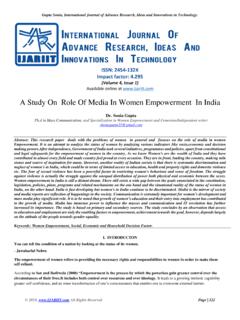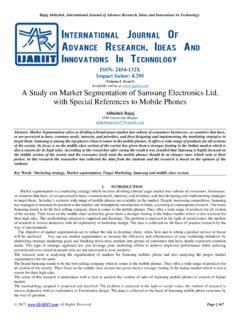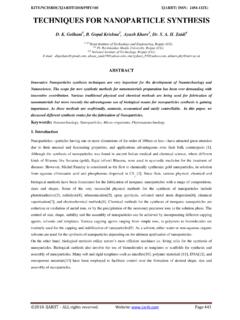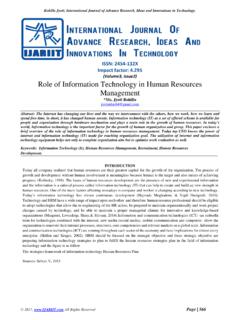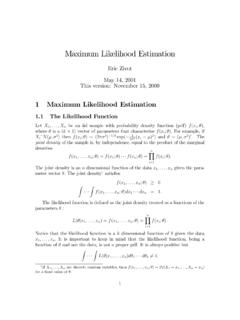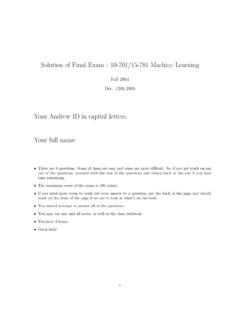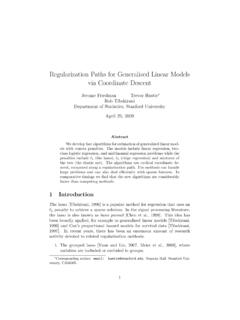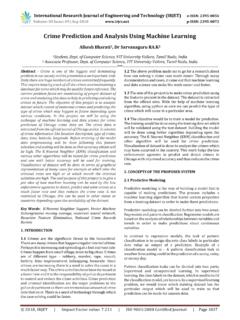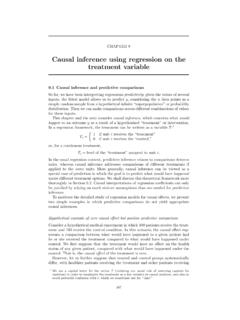Transcription of Fake News Detection - IJARIIT
1 Gahirwal Manisha et. al; International Journal of Advance Research, Ideas and Innovations in Technology 2018, All Rights Reserved Page |817 ISSN: 2454-132X Impact factor: (Volume 4, Issue 1) Available online at: Fake News Detection Manisha Gahirwal Vivekanand Education Society's Institute of Technology, Mumbai, Maharashtra Sanjana Moghe Vivekanand Education Society's Institute of Technology, Mumbai, Maharashtra Tanvi Kulkarni Vivekanand Education Society's Institute of Technology, Mumbai, Maharashtra Devansh Khakhar Vivekanand Education Society's Institute of Technology, Mumbai, Maharashtra Jayesh Bhatia Vivekanand Education Society's Institute of Technology, Mumbai, Maharashtra ABSTRACT Fake news, one of the biggest new-age problems has the potential to mould opinions and influence decisions.
2 The proliferation of fake news on social media and Internet is deceiving people to an extent which needs to be stopped. The existing systems are inefficient in giving a precise statistical rating for any given news claim. Also, the restrictions on input and category of news make it less varied. This paper proposes a system that classifies unreliable news into different categories after computing an F-score. This system aims to use various NLP and classification techniques to help achieve maximum accuracy. Keywords: Stance Detection , Natural Language Processing (NLP), Random Forest. 1. INTRODUCTION Fake news has been around for decades and is not a new concept. However, the dawn of the social media age which can be approximated by the start of the 20th century has aggravated the generation and circulation of fake news many folds.
3 Fake news can be simply explained as a piece of article which is usually written for economic, personal or political gains. Detection of such bogus news articles is possible by using various NLP techniques, Machine learning, and Artificial intelligence. In 2016, the Prime Minister of India, Mr. Narendra Modi declared that most of the cash that people possessed had become worthless and in the span of one month all this old currency had to be deposited in the banks. This led to a chain reaction of a series of fake news being published used mainly for click bait and political gains. News about the new paper bills having a GPS tracker or the daily limit of the amount that can be deposited in banks has increased, were spreading like wildfire. Now, this may not seem like a huge thing but the impact of such articles was so much that there was a point where the Ministry of the Finance had to officially release statements assuring citizens that what they were reading was false information.
4 This is just a small instance of how the spread of false news can impact a much greater audience than it may seem. This paper provides an insight into the procedure of detecting fake news, it's implementation and its results. In order to reach a conclusion on the authenticity of the news article we first take the text article, analyze the data and then use various classification algorithms to classify the news as legitimate or fake. 2. LACUNA IN THE EXISTING SYSTEM I. BS Detector BS Detector is a plug-in used by Mozilla and Chrome browsers to detect the presence of fake news sources and to alert the user works by searching through web pages references of links which have already been flagged unreliable in their database. BS Detector has been used by Facebook to solve their proliferation of fake news lately, they blocked the extension stating that they have been working on their own technique to curb the problem.
5 BS Detector just states a warning message if the article is found to Gahirwal Manisha et. al; International Journal of Advance Research, Ideas and Innovations in Technology 2018, All Rights Reserved Page |818 be does not specify the percentage of error and neither does it classify news into levels of truthfulness or fakeness . II. Politi Fact PolitiFact is a fact-checking US-based website used by editors and writers which gives the credibility of claims by US officials involved American system places judgment in the form of Truth-O-Meter which is a measure of the accuracy of a people first decide on which news to evaluate depending upon some characteristics like significance and worthiness of the that, the Truth-O-Meter is generated and a panel of more than two people thoroughly go through it to evaluate final rating of the claim.
6 The drawback of this system is that human intervention is , it works only for US , every claim is not being fact-checked by them. The choice of evaluation depends upon them. III. Flock Fake News Detector Fake News Detector was a feature added by Flock-a new generation messaging and collaborative platform. Whenever links are being sent to each while chatting, FND algorithm gets checks the content of links to their databases of websites computed according to rankings. It gives a statistic rating and generates a warning message if the source is not found to be database has more than 600 news URL S that are drawback of this system is that their database for fact checking is less in number and chances of hoaxes still not being determined are high. 3. LITERATURE SURVEY While there are some existing applications like BS Detector and Politifact which to some extent help users to identify misleading news but it requires human intervention and also the domain is limited in case of BS Detector which does not give the user the extent of any article to be fake.
7 In [1], they are using linguistic cues approaches and network analysis approaches to design a basic fake news detector which provides high accuracy in terms of classification tasks. They propose a hybrid system whose features like multi-layer linguistic processing, the addition of network behavior are [2], they propose a method to detect online deceptive test by using a logistic regression classifier which is based on POS tags extracted from a corpus deceptive and truthful texts and achieves an accuracy of 72% which could be further improved by performing cross-corpus analysis of classification models and reducing the size of the input feature vector . To detect fake news on social media, [3] presents a data mining perspective which includes fake news characterization on psychology and social theories.
8 This article discusses two major factors responsible for widespread acceptance of fake news by the user which are Naive Realism and Confirmation Bias. Further, it proposes a two-phase general data mining framework which includes 1) Feature Extraction and 2) Model Construction and discusses the datasets and evaluation metrics for the fake news Detection research. In [4], they propose an SVM-based algorithm with 5 predictive features Absurdity, Humour, and Grammar, Negative Affect, and Punctuation and uses satirical cues to detect misleading news. The paper translates theories of humor, irony, and satire into a predictive model for satire Detection with 87% accuracy. The purpose of this paper is to propose a new model for fake news Detection which is using Stance Detection and IF-TDF method for analyzing the data which is taken from various datasets of fake and legitimate news and Random Forest classifier for classifying the output into four classes namely: True, Fake, Mostly True, and Mostly Fake.
9 Using Random Forest gives us an advantage of handling binary features and moreover, they do not expect linear features. 4. METHODOLOGY The aim of this project is to accurately determine the authenticity of the contents of a particular news article. For this purpose, we have devised a procedure which is intended to fetch favorable results. We first take the URL of the article that the user wants to authenticate, after which the text is extracted from the URL. The extracted text is then passed on to the data pre-processing unit. The data preprocessing unit consists of various processes like the Tokenization and Generation of the word cloud. The outputs from these processes play an important role in further analyzing the data. The core deciding factors that we use to determine the output of our project ie if a particular news article is fake or not are the stance of the article and comparison of the article with top google search results.
10 The first method is by using stance Detection to in order to analyze the stance of the author. Stance is a mental or an emotional position adopted by the author with respect to something. Stance Detection is an important part if NLP and has wide stance of the author can be divided into various categories like Agree, Disagree, Neutral or Unrelated with respect to the title. Giving each of these categories weights can help us in the final conclusion of whether a news article is fake or not. The second method is to use document similarity or if-idf to know how similar a document is to top search results. This too can give us an insight into the authenticity of a news article. Next, we need to classify the output into various output classes for which we can use classification algorithms or regression models.


